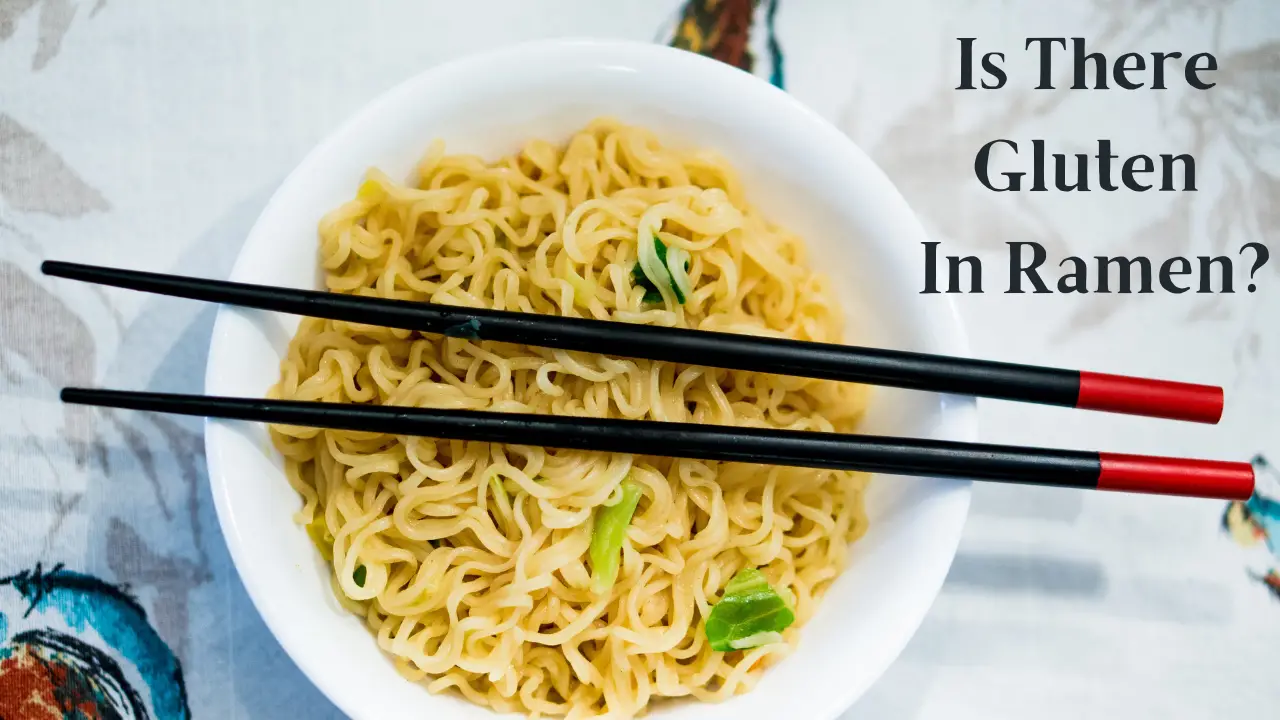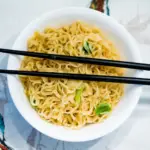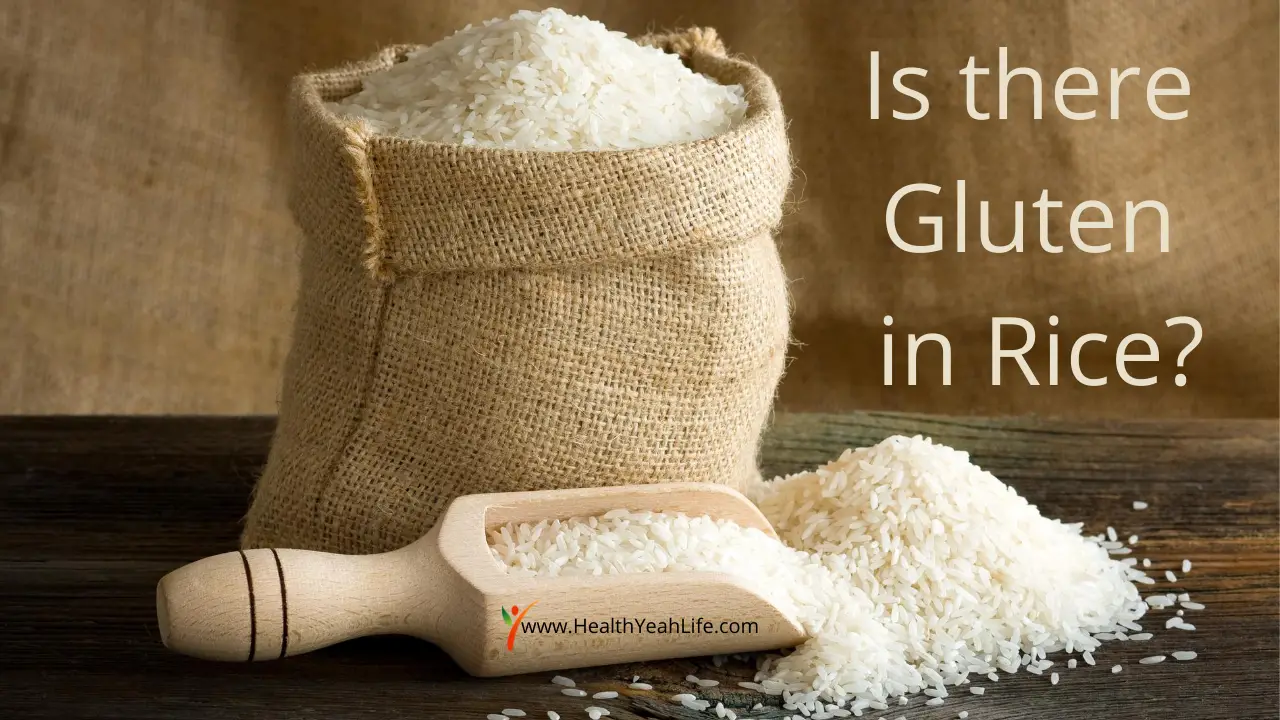College students love ramen; moms often make it for lunch for their kids, and even grownups prefer it now and then. Ramen, in its glory, is a favorite because of its quick cooking time and a tasty filling meal.
On a gluten-free diet, you must research and discard everything that contains gluten. Does ramen fall on that list? Let's find out.
What is Ramen?
Think of spaghetti, the dough of which has different flour types, including durum wheat flour. That's what ramen noodles are, but only using soft wheat flour.
Now, you might be wondering what's kansui? It's an alkaline-based solution that provides a firm texture and yellow color. So, to make ramen noodles, wheat flour, water, salt, and kansui are mixed. Alternatively, eggs are used for this purpose but are more commonly practiced in China than Japan.
A common misconception is to call noodles ramen. However, ramen combines noodles, a rich-flavored broth, and toppings such as protein, vegetables, and seasoning. At the very least, ramen is noodles with broth, rather than just cooked noodles.
History of Ramen
Contrary to the popular belief that Japan is the birthplace of ramen, the actual origin is China. The tradition of soupy noodles in China dates back to the early 1800s.
While the exact story of how ramen became popular in Japan has various versions, the most famous one is this. The concept traveled to Japan several decades later, in the 1860s, after the Meiji Restoration. Once Japan reopened its ports, Chinese immigrants traveled there and introduced ramen.
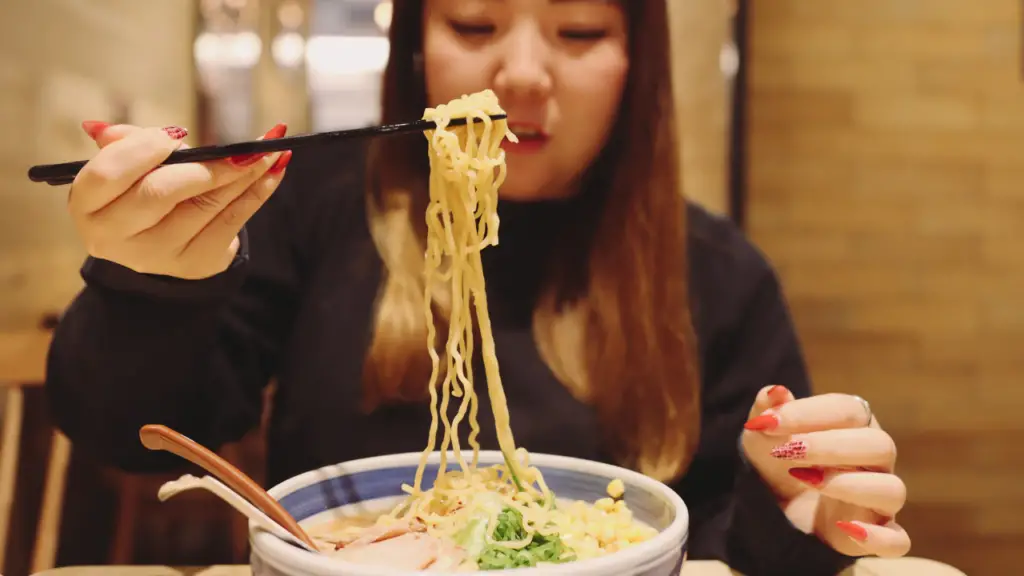
Today, the Japanese take pride in their ramen specialty. It's loved across Japan to such an extent that each region has its variation. But, this ramen craze isn't solely attributed to Japan only in the modern era. With ramen becoming more convenient to cook and a filling meal, it's now consumed worldwide.
What is Gluten?
The term ‘gluten' is everywhere nowadays, with more and more hype on gluten-free foods and diets. The critical question is, do you know what it means?
Gluten is a protein mainly found in cereal grains, including wheat, barley, rye, and triticale. The component enables the dough to rise, have elasticity, and shape. Meanwhile, gluten isn't just in these grains but also food products containing them.
Gluten is ordinarily harmless, but their bodies cannot digest it for some people. It causes various digestive symptoms but can also include other systems. While this protein has numerous advantages in cooking and baking, it wreaks havoc in other places.
When a person reacts to gluten, the diseases are celiac disease or gluten intolerance. Both have similar symptoms; however, celiac disease is an autoimmune condition. In other words, it's a genetic condition. The only treatment, as of now, for celiac and gluten intolerance is a gluten-free diet.
Does Ramen Contain Gluten?
Now that you know all about ramen noodles and gluten, it is time to jump to the real question. Does ramen contain gluten?
Remember that ramen noodles are made from wheat flour, salt, water, and kansui. And gluten is mainly found in wheat, barley, and rye. So, the main ingredient in ramen, noodles, is contaminated by gluten.
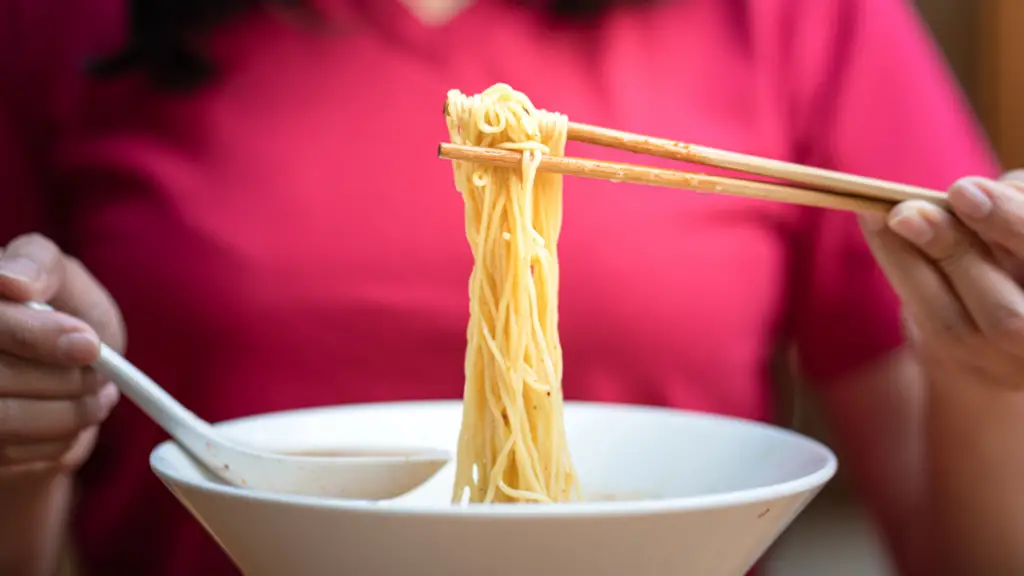
Ramen is incomplete without broth and seasoning. We know that noodles contain gluten. But do the broth and seasoning contain gluten? Well, that mainly depends on the brand and flavor.
For instance, many brands use dehydrated soy sauce or hydrolyzed wheat protein to make the sauce. The seasonings may also contain MSG and several other chemicals derived from wheat.
But that does not mean that you won't find any gluten-free ramen. Some brands use millet or brown rice instead of wheat to make the noodles. Others ensure that neither the broth nor the seasoning contains any derivatives that are a source of gluten.
You can also make gluten-free ramen at home. In the subsequent sections, we have discussed both these remedies in detail.
Hence, ramen noodles, broth, and seasoning usually contain gluten to answer the question. But, you can also find gluten-free ramen or make it yourself.
Is It Healthy to Eat Ramen Every Day?
Ramen noodles are quick, cheap, and easy to make. Some people choose ramen because of its taste, while others prefer its ease and accessibility. But whether you're a celiac patient or not, ramen may not be the healthiest option.
Many health experts and researchers have debated how much ramen is okay to eat. Although the answer varies from person to person, the safe limit is to eat once or twice a week. Since ramen is not an ideal option, regularly eating it can lead to several complications. Here are a few health risks if you eat ramen daily.
Low Nutritional Value:
For starters, each package of ramen is a source of almost 14 grams of saturated fat. This amount is equivalent to about 40 percent of the recommended daily intake. Not only that, but their nutritional value is poor since they contain low amounts of protein, vitamins, minerals, and fiber. For this reason, ramen is notorious for causing weight gain.
Chemical Additives
Moreover, most ramen brands add preservatives, flavorings, and artificial sweeteners. Such compounds are hard to break down and detoxify by the liver. With excessive ramen consumption, the liver gradually gets overwhelmed, and eventually, this vital organ gets significantly damaged.

Ramen is also known for increasing the risk of cardiovascular disorders, predominantly due to the exceptionally high sodium content.
Keep your intake low, and ramen won't negatively affect your health.
Gluten-Free Ramen Brands
The best option for a celiac patient is finding a gluten-free brand or making homemade ramen. We are sharing a list of the best brands that make certified gluten-free ramen to make it easier. Whether you tend to shop online or at the store, keep an eye out for these brands:
Lotus Foods:
Lotus Foods is the leading gluten-free ramen noodles brand, according to numerous food bloggers, experts, and customers. The company boasts a unique and delicious taste, and the variety of gluten-free flavors is simply astonishing. The brand's Organic Millet and Brown Rice Ramen is a fan favorite. You can also find it at your local Costco.
Thai Kitchen:
Another brand with a strong foothold, especially in the US, is Thai Kitchen. The numerous gluten-free flavor choices and their distinct delicious tastes make this company's ramen noodles irresistible.
Moreover, you can eat Thai Kitchen's ramen right in the bowls the company packages them. Try their Gluten-Free Stir Fry Rice Noodles.
Big Green Organic Food:
Big Green Organic Food is famous for its gluten-free ramen. The company uses different gluten-free flours to make its ramen. Sorghum Ramen is the most liked and consumed among the different flavors and types. Try their buckwheat, black rice, and brown rice ramen.
King Soba:
You can not truly embrace the gluten-free noodle culture without trying King Soba first. The brand has taken an excellent initiative to make organic, vegan, and gluten-free noodles that satisfy the palate. All of the company's products are certified by USDA. So why not try their yummy Organic Brown Rice Ramen Noodles?
Mr. Lee's Noodles:
Mr. Lee's Noodles have taken things to another level. Not only do they make gluten-free noodles, but their ramen does not have any artificial flavors, colors, preservatives, or MSG. In addition, they also use 100 percent recyclable packaging. And when you get a taste of all this, what more do you need? Their Hong Kong Street Beef is a must-try.
Gluten-Free Ramen Recipe
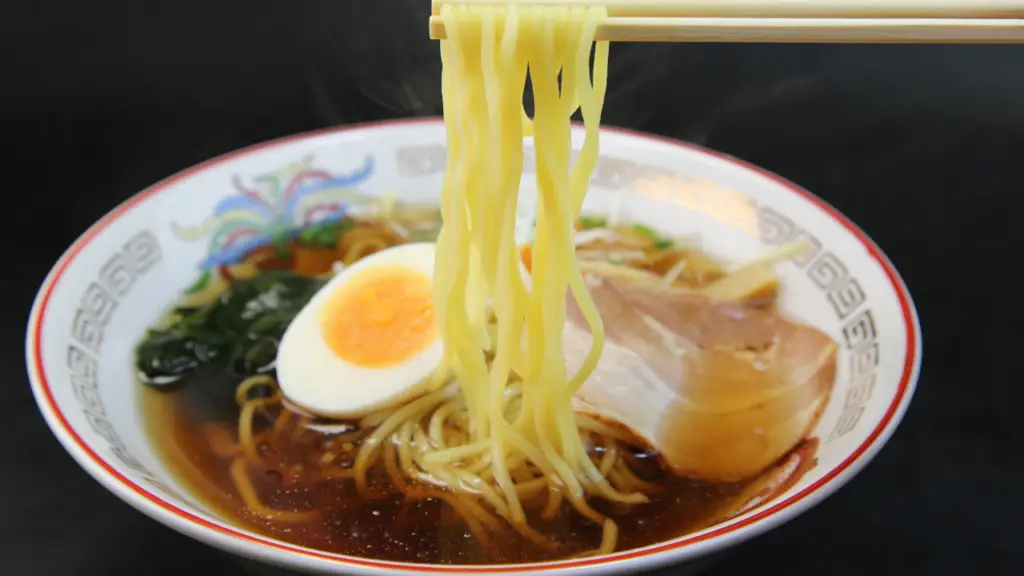
Instead of using the seasonings in instant ramen, why not make an authentic ramen dish? This recipe uses gluten-free ramen that you can get from any of the brands above. Plus, you can go all out and experiment with different vegetables, proteins, and toppings.
Ingredients:
- 2 eggs
- 2 gluten-free ramen nests (I suggest Lotus brand, from the list above)
- 1 tablespoon sesame oil
- 1 small onion, chopped
- 1 tsp. ginger garlic paste
- 2 cups chicken stock
- ¼ cup gluten-free soy sauce (tamari)
- 2 tbsp. rice vinegar
- 1 tsp. hot sauce/sriracha sauce
- 1 chicken breast, sliced
- 1/3 cup mushrooms
- 1/3 cup zucchini, cut
- 1/3 cup bok choy, cut
- 2 scallions, chopped
Directions:
- Boil the eggs in a saucepan for 7-8 minutes. Remove into cold water and peel the shell.
- Place your pan on the stove and slowly heat the oil. Add onions and ginger-garlic paste. Keep frying until the onions turn translucent.
- Add the stock, soy sauce, vinegar, mushrooms, bok choy, and hot sauce in the pan. When the said mixture comes to a boil, bring down the heat and add chicken and noodles.
- Let all ingredients above simmer for 15 minutes or until the chicken and noodles are cooked thoroughly.
- Divide the ramen equally into two bowls.
- Cut the egg into half and place one half on each bowl.
- Add cilantro, scallions, and squeezed lime juice on top.
Final Words
You're in for a treat once if you have never tried ramen. As long as you choose these gluten-free ramen brands, you don't have to worry about them containing gluten. They go wonderfully with a gluten-free diet and are also utterly delicious.
You won't even miss the traditional ramen. Try these brands with different broth flavors, and you might come across a personal favorite too! Keep in mind to eat ramen sporadically. Adding fresh vegetables and protein make for an outstanding gluten-free meal.
Gluten-Free Ramen Recipe
Ingredients
- 2 Eggs
- 2 Ramen Nests Gluten-Free
- 1 tbsp Sesame Oil
- 1 tsp Ginger Garlic Paste
- 2 Cups Chicken Stock
- 1/4 Cup Gluten-Free Soy Sauce Tamari
- 2 tbsp Rice Vinegar
- 1 tsp Sriracha Sauce
- 1 Chicken Breast Sliced
- 1/3 Cup Mushrooms Sliced
- 1/3 Cup Zucchini Cut
- 1/3 Cup Bok Choy Cut
- 2 Scallions Chopped
Instructions
- Boil the eggs in a saucepan for 7-8 minutes.
- Remove into cold water and peel the shell.
- Place your pan on the stove and slowly heat the oil. Add onions and ginger-garlic paste. Keep frying until the onions turn translucent.
- Add the stock, soy sauce, vinegar, mushrooms, bok choy, and hot sauce in the pan. When the said mixture comes to a boil, bring down the heat and add chicken and noodles.
- Let all ingredients above simmer for 15 minutes or until the chicken and noodles are cooked thoroughly.
- Divide the ramen equally into two bowls.
- Cut the egg into half and place one half on each bowl.
- Add cilantro, scallions, and squeezed lime juice on top.
The owner of this website, HealthYeahLife.com, participates in the Amazon Services LLC Associates Program, an affiliate advertising program designed to allow sites to earn advertising fees by advertising and linking HealthYeahLife.com Review to Amazon properties including, but not limited to, amazon.com.

